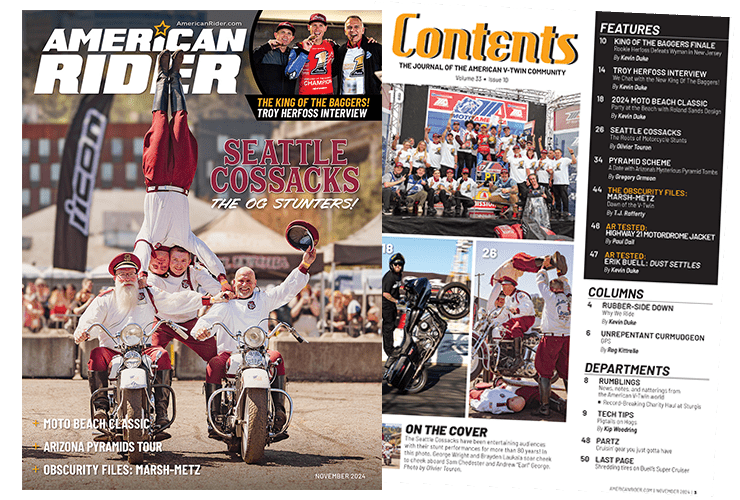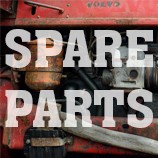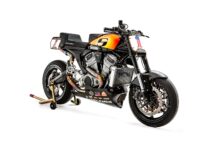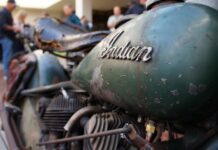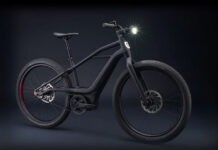Eddie Davenport didn’t have his feet on the dashboard of a convertible in the famed Life magazine photo of the 1947 Hollister “riots.” It was a Harley, though reportedly not his. If he and his cronies were all driving convertibles that weekend, maybe convertible drivers would be the bad-asses? A recent weekend spent with a convertible made me wonder how bikes and convertibles could be so similar, yet worlds apart.
Full disclosure: in addition to growing up around motorcycles, it was not uncommon for European convertibles to pop up around our house from time to time. Specifically, French-made Renault Caravelles. My dad and uncle would drag them home with a tow bar that they welded up to fit, fix them and flip them before flipping was a word. Later in life, Dad desperately wanted a Pontiac Fiero convertible, but the factory never made one. So he took matters into his own hands and made it himself, with the help of a few key craftsmen including Joe Pauletich and Bill Marino. Joe cut off the old hardtop and did the fab and body work while Bill stitched up a soft top following Dad’s design that was car wash watertight. When it was finished it looked like a factory job and worked well for years.
My recent weekend convertible experience was fun, no doubt. Good looking, sporty performance, wind in your hair, and the sudden urge to pull into grist mills converted to antique shops or wineries. Just like on a bike, the radio is hard to hear and so are your partner’s comments. Shorts, shades and sandals replaced boots and jeans, and caps or sun hats replaced helmets. In spite all of that, the experience of driving a convertible is much closer to riding a bike than it is to driving a car, but it’s still a world away.
In the beginning, cars had soft tops for economic reasons. Later, when steel roofs arrived, they maintained a soft panel in the center. According to my elders, that was because they were afraid a total steel top would create the environment of riding inside a drum. Due to the cumulative effect of hearing it at every car show I ever went to, I know that General Motors produced the first domestic all steel-roofed vehicle in 1934 and there’s been a market for convertibles ever since.
So if a convertible is a car’s attempt to become a motorcycle, why haven’t enclosed motorcycles become popular? Let’s see; how about because they’re goofy? It’s not that they aren’t made. They are. I know where a weird production-built three-wheeled scooter sits with a roof on it right now. It’s called an AutoMoto, which is funny because it’s neither, but it is an interesting design and if it ever runs again, I’d like to take the 150cc oddity for a putt.
I’ve seen several attempts to create homemade enclosures for bikes, though a scooter is usually the victim of this endeavor. I’ve never seen a roof on a Harley or Indian. I’m not saying it hasn’t been done; I just haven’t seen one. If you pursue putting a roof on your bike, I think you’re flirting with micro-car status. The American-made biking community seems generally immune to the desire for full enclosure for the most part, though we take partial enclosure as far as it can go with aero-tested windscreens, fairings and lowers. That’s where we seem to draw the line, although we will argue among ourselves about almost every level of protection, which at its core is a type of enclosure, from helmets to long sleeves.
Enclosing a motorcycle is not an easy task. If you just put a roof on it, it’s isn’t very weatherproof and if you add sides, you’re entering an entirely different dimension. How do you get your feet down to start and stop? Do you add hydraulically-activated training wheels? Yuck. And what of ingress and egress? Besides all of that, even if you did it successfully it just wouldn’t be that cool. I mean that literally and figuratively. Fogged-up windshields would be an issue too.
Convertible cars are a very distant cousin to motorcycles, providing an experience that is as far removed from enclosed cars as it is motorcycles. Convertibles are to motorcycles what vacation homes on the beach are to hunting camps in the mountains. Convertibles offer modern conveniences such as locking trunks, climate control and increased safety. If it rains and you’re on your bike, you get wet. In a convertible, you press a button or at worst, pull over and put the top up. Maybe that’s the biggest difference of all—commitment to the experience.
I’ve often heard the story describing the difference in the levels of involvement between a chicken and a pig when it comes to your ham-and-egg breakfast. The chicken, it is said, is involved; the pig is committed. In this example bikers would be the pig. Nobody I know ever described driving a convertible as a lifestyle.

